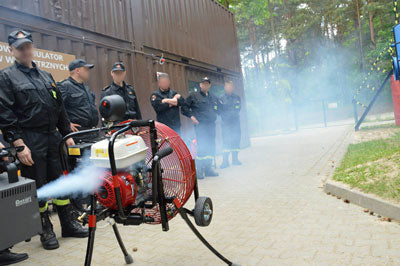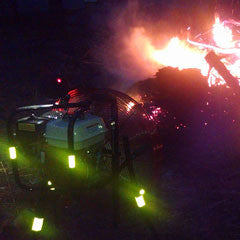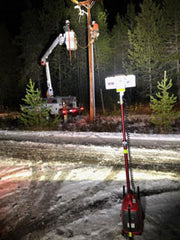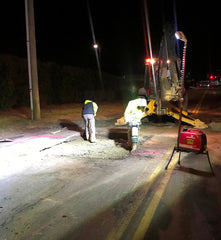Positive Pressure Ventilation Fan Testing
Over the last 30+ years, thousands of customers have put Ventry® Fans to the test, including the UL Firefighter Safety Research Institute (FSRI). In addition to the UL positive pressure ventilation (PPV) study, the following two tests may be helpful.

Four of the seven PPV fans tested. Photos used with permission, courtesy of Szymon Kokot-Góra
PPV Fan Tests in Olsztyn, Poland
Extensive tests with seven types of PPV fans, to help optimize its training curriculum for tactical ventilation, were carried out in 2014 by the Training Division of the Regional Headquarters of the State Fire Service in Olsztyn (Poland).
An article about the tests was published in “Testing Time for PPV” in Fire & Rescue magazine.*
“The firefighting world is awaiting the results of the UL Firefighter Safety Research Institute’s breakthrough research on PPV,” writes Junior Brigidier Szymon Kokot-Góra (formerly Senior Captain). In the meantime, his article covers some of the findings from their training.

“Using smoke machines and applying the smoke from behind the fan can help visualize the shape of the stream and give a better understanding of the positive pressure streams.” (Kokot-Góra, p. 41)
For more photos, see Osrodek Szkolenia KW PSP Olsztyn - Fire Training Division, Facebook album “Szkolenie z wentylacji nadcisnieniowej/PPV training”
“An important aspect was the fan’s weight and dimensions, which directly influence the possibility of its use in initial stages of a response...” (page 43). It does not matter how well a fan works if it is too heavy to get on the truck or move!
“...the [cone of air and door seal rules of the past] become obsolete with improvements made in the equipment. Nearly all brands are introducing so-called ‘turbo ventilation’ which also enables setting the fan farther back from the inlet, allowing for operating space near what is usually the main entrance.” (page 41). Ventry Solutions does not call it ‘turbo ventilation’ but our fans have always done this.
The main goals were to determine the best position for each fan and to better understand the aerodynamics of PPV. They measured the outflow of each fan at different distances and the carbon monoxide levels (all fans were gasoline-powered). The wentylator (ventilator) types he describes as miglowy (propeller), tradycyjny (traditional), and typu turbo (turbo).
We have duplicated the results tables on page 42 below to show standard units and highlighted some points to call out important relative data. Metric units are shown in the article itself.
Click the image for a larger view (opens in a new window). Close the window to return.
*Source: Kokot-Góra, Szymon. “Testing Time for PPV” Fire & Rescue, International Independent Intelligence, 1st Quarter 2014. Hemming Group. (Last access 2-17-2016) -- NOTE: The article is posted online, page 40, at the address http://ebooks.hgluk.com/~production/ebooks/FireandRescue/FIREANDRESCUE_Q1_2015/pageflip.html but we get a hazardous website warning if we go there so we do not recommend it! Instead, a PDF file is available upon request. Email us and specify Szymon’s article dated 201503.
PPV Fan Tests in Austin, Texas

Simplified section of Figure 3 (showing exhaust flow at different distances from the door) from the paper “Investigating Positive Pressure Ventilation.” Click the image to see the complete graph.
A similarly scientific approach was taken in 2005. Two Ventry® Fans and two fans from a leading competitor were tested by the Austin Fire Department, University of Texas at Austin and The Swedish Rescue Services Agency.
In the “Travis House Study” the researchers measured the flow rates of the four fans at different distances from the door, knowing that “more flow rate is always better than less" for effective PPV (p. 5). While the goal of the study was to investigate PPV in large structures---not to compare fans---the results are very favorable to the Ventry brand.
Here are two points from the research that we’d like to highlight. In an apples-to-apples comparison---the two fans both with 6.5 hp Honda® GX200 engines (now rated 5.5 hp) and 24-inch propellers---the Ventry PPV Fan pushed greater airflows at all distances tested, up to 4 times that of the competitor. Even more compelling is how well our small fan also out-performed the competition. At six feet from the door, our 4 horse 20-inch Ventry Fan (now 3.5 hp) pushed essentially the same air flow as the 6.5 hp 24-inch competitor. At 12 feet, the small Ventry Fan pushed 2.8 times the air flow of the larger competitor.
Given the better performance despite smaller size and horsepower, the researchers suggest that “factors other than the motor rating of the fans should be considered as being important when a fire department selects fans for use in PPV” (page 5). Progressive departments that recognize and use PPV as a life-saving tactic should also choose the best fan for the job.
Since the tests, Austin Fire Department has purchased many Ventry Fans.
Source: “Investigating Positive Pressure Ventilation.” Authors: Ofodike Ezekoye of the University of Texas, Austin; Dr. Stefan Svensson of the Swedish Rescue Services Agency; and Robert Nicks of the Austin Fire Department. Retrieved March 3, 2008 from http://www.me.utexas.edu/~ezekoye/rsch.dir/documents/TravisHouseStudy.pdf (The link is no longer active but the document is available upon request from VSI.)
Share this post
Latest News & Articles
Brush Burning Fans
Several of the unique qualities which make Ventry Fans ideal for fire fighting also make them a great investment for brush/slash burning. Contractors often want 4 or more brush burner fans for huge land clearing projects; they soon realize only one Ventry Fan is needed!

Photos compare lighting options for Linemen
Photos by local linemen: They tested safety lighting solutions during overhead pole work and trench work. Photos compare headlights, spotlight, and Lentry® Portable Lighting.

Lentry Lights make quick work of nighttime repairs
See how Lentry Light Systems with a single LED light head help utility companies see and be safer when having to work at night.

Stay in touch
CALL US
We’d love to hear from you and will be happy to answer your questions and assist you with our products. Call (888) 257-8967.
E-NEWSLETTER
Sign up here for our once-a-month email of GREAT NEWS!

